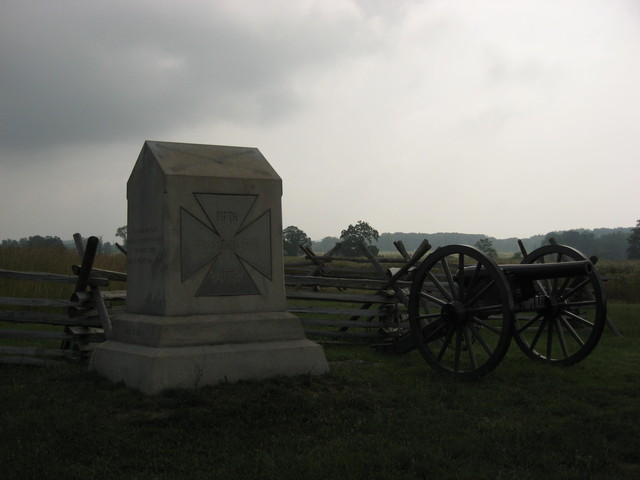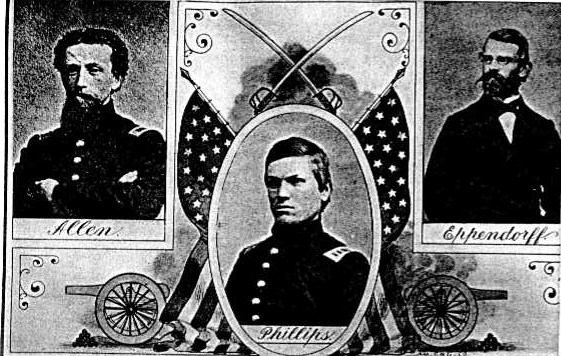
Light Artillery
Army of the Potomac, Inc.

The 5th Massachusetts Battery was organized in the fall of 1861 by George D. Allen of Malden and John B. Hyde of New Bedford, both of whom were commissioned 1st Lieutenants in the Battery. On September 30, the nucleus of the organization went into camp at Camp Schouler, Lynnfield Ma, where it remained until November 14 then transferred to Camp Massasoit, later called Camp Meigs) Readville.Ma. for artillery training. Max Eppendorf, a native of Saxony and a former artillery officer in the Saxon army, was commissioned Captain, by Governor Andrews October 23rd.

The process of recruiting continued through November of 1861, and most of the original members of the battery were mustered on December 3. The battery left for Washington, D.C. on Christmas Day, arriving two days later and was quartered at Camp Duncan,(later called Camp Sumner) Capitol Hill. On January 27, Capt Eppendorff resigned his commission, because of poor health, and 1st Lieutenant George D. Allen succeeded as Captain on February 17.
On February 12, the original guns of the battery, four rifled 6 pounders and two 12 pounder howitzers, were exchanged for six 3 inch Ordnance Rifles.
About this time, the Battery was assigned to Fitz John Porter's Division which later became a part of the 5th Corps, Army of the Potomac. The battery moved to Halls Hill, Va and Capt Charles Griffin Battery D, 5th US, was assigned as our drill instructor.
Marching order were received Mar 18 and the battery moved to Camp California, near Alexandria,Va embarking for Fortress Monroe. Reaching Fortress Monroe, March 24,1862,the battery went into position at the New Market brigade until April 4. On the 4th, our first shot was fired at the enemy at Howards Mills, where the battery exchanged several rounds with the enemy. It was present at the siege of Yorktown in April, but was not seriously engaged. Assigned to Morell's Division, Porter's (5th) Corps, it was present at Hanover Court House, May 27, without loss.

For a month before the opening of the Seven Days battles, it was encamped on the Dr. Gaines farm, the men doing picket duty. Captain Allen left for Ft.Monroe on May 29 sick leave and eventual resigned. At Gaines' Mill, June 27, under command of 1st Lieut. John B. Hyde, it was attached to Butterfield's Brigade and was very heavily engaged, losing four guns, two men killed, four wounded, and two missing, together with 22 horses. With the two guns remaining, it rendered valuable service at Malvern Hill, July 1, then retired to Harrison's Landing. While there, on July 12, the battery ceased for awhile to exist as an independent organization, with twenty-five of its men being assigned temporarily to the 1st RI Battery C under Command of Capt Weedin while the rest of the officers and men were assigned to the 3rd Mass. Battery under the command of Capt Martin. While our men were with the 1st RI, they were engaged at the battle of 2nd Bull Run, where one of men was wounded.
Returning to the defense of Washington early in September, the Battery was stationed successively at Upton's Hill and Fort Corcoran awaiting new guns. Having requipped, it rejoined its division at Sharpsburg around October 10th. Lieut. Charles A. Phillips was promoted to Captain.
On December 13, 1862, the 5th Battery crossed the Rappahannock at Fredericksburg and went into position near the Poor House, being sharply engaged during the latter part of the action. It participated in the "Mud March" in January 1863, and in the movement to Chancellorsville around May 1. After this campaign it was attached to McGilvery's Reserve Artillery Brigade and with it participated in the Battle of Gettysburg, July 2 and 3. Here the Battery lost seven men killed and 13 wounded together with 59 horses. Soon after this battle the Battery rejoined the 5th Corps.
 |
MONUMENT TO THE MEN OF THE 5TH MASSACHUSETTS BATTERY AT GETTYSBURG DEDICATED OCT 8TH, 1885 LOCATED ON SICKLE'S ROAD NEAR THE PEACH ORCHARD 700 ROUNDS FIRED CHS. A. PHILLIPS, CAPTAIN, COMMANDING JULY 2D, 1863 |
On November 7, it was engaged at Rappahannock Station, and during the latter part of the same month it participated in the Mine Run campaign. The winter of 1863-64 was spent in the old earthworks at Rappahannock Station.
May 4, 1864, the Battery crossed the Rapidan at Germanna Ford. It was slightly engaged at the Wilderness, May 5, and was in action on the Union right near Spotsylvania, May 9 to 12. The unit was engaged at Bethesda Church, June 3, and near Bottom's Bridge, June 8, losing in this campaign six men killed and several wounded.
Crossing the James River, June 13, on the 18th, the Battery was in action before Petersburg, and was again engaged July 30 during the Battle of the Crater. It was in the movement to the Weldon Railroad, August 18 to 21, and was stationed at various places on the east front of Petersburg during the late summer and fall.
On August 30, the recruits and re-enlisted men of the 3rd Massachusetts Battery were transferred to the 5th Battery and on October 3, the members of the 5th Battery who had not re-enlisted were discharged and sent home. Thirty-nine of the original members of the Battery re-enlisted in the winter of 1863-64 and, with the recruits received in 1864, kept the numbers up to the required standard, and the battery continued its existence as a veteran organization.
The 5th Battery was in the movement to Hatcher's Run, October 27, and to Jarrett's Station on the Weldon Railroad during the second week in December.
About December 19, two of its guns were stationed in Battery XXII while the other four were placed in Fort Alexander Hays. Various movements took place during the winter of 1864-65, but the opening of Spring found the Battery at Fort Alexander Hays.
On April 2, the day of the general assault on Petersburg and after the capture of the Confederate battery position near the Jerusalem Road known as Battery No. 27, two detachments from the 5th Battery under 2nd Lt. M. W. Page were sent into the captured works to assist in turning the captured guns against the enemy. Lt. Page and three men were severely wounded, the last loss of the Battery in action.
During the succeeding night, Petersburg was evacuated and a day or two later the Battery was withdrawn to City Point. Remaining here about a month, on May 3, 1865, it started on its last march, passing northward across Central Virginia and reaching the defenses of Washington May 13. On June 2, the guns and equipment were turned in and two days later the officers and men entrained for Boston. Camp Meigs, Readville was reached June 6, and on the 12th the members of the 5th Massachusetts Battery was mustered out of the United States service.